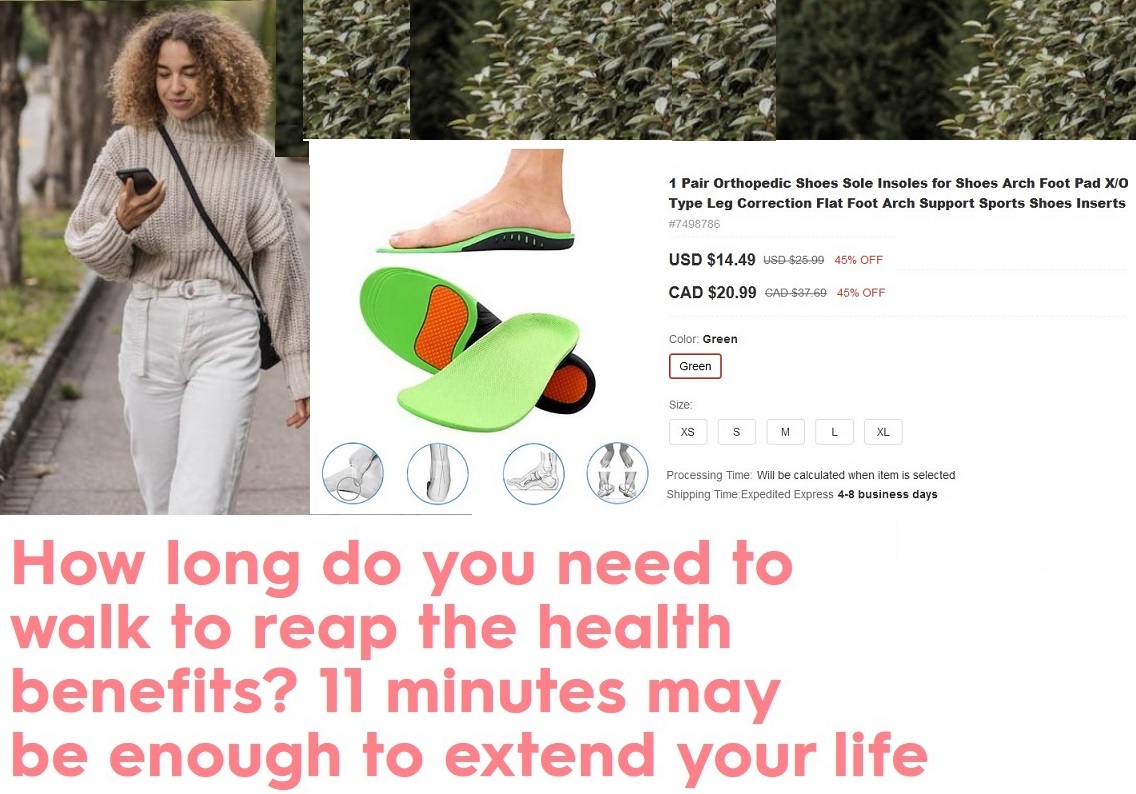AFFORD Total Knee, Hip Replacement in Cuba Without the Wait at 1/5 of Your Home Hospital Cost
What to do while waiting for hip replacement surgery
While waiting for hip surgery you can prepare by making sure that you are in good mental and physical condition. Taking care of your diet and making good lifestyle choices will help get your body ready for surgery.
How to minimise pain and pain relief while waiting for hip replacement surgery
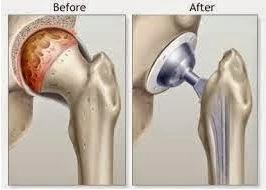 Planning activities of daily living can help to minimise pain and discomfort, you may find that making small adjustments helps. Doing daily tasks such as walking, driving or sitting at a desk can add to hip discomfort, so be sure to pace yourself. You can find some handy tips in our signs you need a hip replacement blog. Taking prescribed pain relief prior to a hip replacement can help keep you mobile and ease the discomfort caused by daily activities, such as bending down, getting in and out of the car or bed. Your GP or consultant will be able to advise on the best pain relief to suit you.
Planning activities of daily living can help to minimise pain and discomfort, you may find that making small adjustments helps. Doing daily tasks such as walking, driving or sitting at a desk can add to hip discomfort, so be sure to pace yourself. You can find some handy tips in our signs you need a hip replacement blog. Taking prescribed pain relief prior to a hip replacement can help keep you mobile and ease the discomfort caused by daily activities, such as bending down, getting in and out of the car or bed. Your GP or consultant will be able to advise on the best pain relief to suit you.
The impact of waiting for hip surgery
Waiting for treatment or surgery can have significant implications. It may mean spending longer in high levels of pain, which impacts quality of life. In some patients it may also mean an increased risk of emergency admission due to fractures or make the hip surgery more complex and costly due to worsening condition of the joint.
Why limp around in pain waiting? You can afford hip/knee replacement in Cuba even if uninsured or on-benefits
We are a Paid Directory. How It Works?
Wanna reach out directly and negotiate your issue with Cuban clinic on your own?
Negotiate discretely your issue with Cuban clinic on your own. If you are looking for Cuban dental contact Don't hesitate to DROP US A LINE to drcubamd@gmail.com With modest EUR 5.- only we can be helpful
Absolute Confidentiality. We charge by PAYEER
What you need to know about knee replacement
The primary reason for this surgery is severe arthritis of the joint. Arthritis means the destruction of cartilage (protective coating of bones at the joints) that cover the bones at and near the joint. When the cartilage is destroyed, the bone ends are exposed and this causes the raw bone ends to touch each other which causes inflammation of the bone ends. This inflammation leads to pain in the joint.
What is Total Knee Replacement?
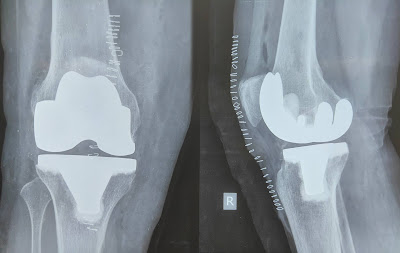 Knee replacement is a surgical procedure to resurface a knee damaged by arthritis. Though the procedure is called total knee replacement, we are not removing or replacing the entire knee bones or all the parts seen in a model of knee that you find on doctor's table. Here we are removing only the surface of the knee bones that comes into contact with each other and are replaced by metal and plastic parts that cap the ends of the bones. This forms the new knee joint. This newly placed metal and plastic parts prevent the bone ends from touching each other and thus allows a pain free knee movement.
Knee replacement is a surgical procedure to resurface a knee damaged by arthritis. Though the procedure is called total knee replacement, we are not removing or replacing the entire knee bones or all the parts seen in a model of knee that you find on doctor's table. Here we are removing only the surface of the knee bones that comes into contact with each other and are replaced by metal and plastic parts that cap the ends of the bones. This forms the new knee joint. This newly placed metal and plastic parts prevent the bone ends from touching each other and thus allows a pain free knee movement.
Does all the knee arthritis require Knee Replacement?
No. In the initial stages when the cartilage damage is less, the bone ends touch with each other only when there is a heavy impact, like a fall, jumping, a day of heavy work etc. In such situations the inflammation of the bone ends can be controlled by anti-inflammatory medicines and adequate rest. Once the pain subsides the patient can resume to their usual works without any pain. Patient should avoid the high impact works which if done again brings back the pain.
In cases of severe arthritis even walking become a heavy impact work for the knee. In such cases patient may get a relief of pain on taking medicines and rest. But the pain will again return soon after stopping medicines so that patient needs medicines most of the days. These medicines are good if taken for few days, but will create other problems if taken for long time. These are the patients who will benefit from a total knee replacement.
What are the medicines that doctor usually prescribes in cases of early arthritis?
The anti-inflammatory medicines can be either a Non Steroidal Anti Inflammatory medicine(NSAID) like Diclofenac or a Steroid. Both can be taken as tablets or injections directly to the joint. Both these medicines are very effective in managing an acute episode of pain. But if taken for long time (like a month) these can create a lot of problems like kidney damage, uncontrolled blood sugar etc….
Are there any medicines that will help to grow back the damage cartilage?
No. So far no medicines have proved to grow back the damaged cartilage. There are several medicines available in the market that claims to regenerate the damaged cartilage, but none have proved to be effective. The fun fact is that most of the so-called medicines (both allopathic and ayurvedic) that claim to regenerate the cartilage are not even licensed from government to sell as medicines, and are selling as food supplements (similar to Horlicks, boost etc.…). Next time you buy a medicine for knee arthritis, make sure to check the label whether it's a food supplement or a medicine.
How Does TKR Help?
In Knee Replacement your doctor removes the surface of the knee bones that comes into contact with each other. These surfaces are replaced by metal and plastic parts that cap the ends of the bones. This newly placed metal and plastic parts prevent the bone ends from touching each other and thus allows a pain free knee mobility.
Care After Surgery
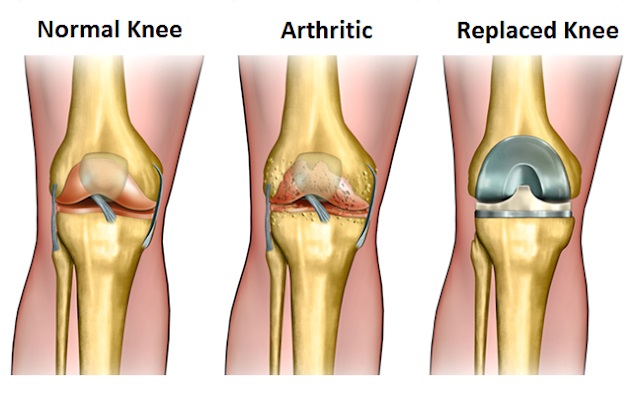 After the surgery, in our clinic we usually advise you to get up and walk the next day of surgery. You have to use a walker support for 1 month after surgery (you will be able to walk without a walker as early as 1 week after surgery, but we usually advices to use walker for a month till the cut bone and muscles heal well, just as a caution against any accidental fall which can create problems if occurs before complete healing of tissues). A physiotherapist, will meet you and teach some exercise & movements to improve and strengthen the knee.
After the surgery, in our clinic we usually advise you to get up and walk the next day of surgery. You have to use a walker support for 1 month after surgery (you will be able to walk without a walker as early as 1 week after surgery, but we usually advices to use walker for a month till the cut bone and muscles heal well, just as a caution against any accidental fall which can create problems if occurs before complete healing of tissues). A physiotherapist, will meet you and teach some exercise & movements to improve and strengthen the knee.
It really is perfectly common to experience initial discomfort and pain while walking and exercising. Continue exercising and you will reach normalcy soon. Follow the instructions set by your surgeon and follow up on your visits.
Is it really painful after the surgery?
No. Gone are the days when the patients complain of severe pain after a total knee replacement. Now most of the centres including ours follow a multimodal pain management protocol that allows the postoperative period absolutely comfortable. With todays advanced medicines and techniques most of our patients do not complain of pain at all.
What is a "non muscle cutting" total knee replacement seen in ads of some hospitals? Is there any benefits of doing so?
By the term "non muscle cutting" it usually refers to subvastus approach to the knee. "Approach" means the way your surgeon reach till the knee bones. The most commonly used approach is 'medial parapattellar approach' where the surgeon cuts the muscle (and tendon) on the front of your thigh to reach the knee bones. In the Sub-Vastus approach your surgeon will retract the muscle to one side (without cutting the muscle) to reach the knee bones. The cut on skin is same for both.
The subvastus approach allows you to walk earlier and more comfortably compared to the other technique. Also, the patients for whom subvastus approach was done, reports less pain. Simply speaking the subvastus approach (or the non muscle cutting technique) makes the initial period after surgery little more comfortable. Don't worry you have already done the replacement by the other technique; the results and function after a longer time are similar for both techniques.
From the surgeon's point of view the subvastus approach (or the non muscle cutting technique) is little difficult to perform. Few centres including ours are routinely performing this non muscle cutting technique in most of the cases (except for the patients whose particular anatomy makes it impossible to do so).
Its perfectly ok to ask your surgeon about which method he is planning to do, and you can take your decision accordingly.
What is a cruciate retaining knee replacement?
A cruciate retaining knee replacement is the one in which your posterior cruciate ligament(is a structure that connects your knee bones together inside the knee) is preserved. This again is little difficult to perform from the surgeon's point of view.
This technique is claimed to produce a near normal knee after a total knee replacement. Also, it may be little easier for both you and surgeon if in case you need a repeated knee replacement on the same knee which may occasionally happen. Other than these, the cruciate retaining knee replacement has no proven benefits compared to the other.
Few centres including ours are routinely performing cruciate retaining knee replacement in all the possible cases.
Its ok for you to ask about which technique your surgeon is planning for you, and you can decide accordingly. But it's better that you don't compel your surgeon to do the cruciate retaining replacement if he is comfortable with the other technique. Cruciate retaining surgery needs perfection and if not done perfectly, can create more problems than the minor benefits.
How much does it cost to replace a knee?
The cost varies from hospital to hospital and surgeon to surgeon. Also, there can be variation in same centre and same surgeon depending the hospital services that you choose (like the rooms you take) and the implant that is used. The cost in Cuba typically varies between $ 12 K to $ 15 K. Most of the hospitals will have a package and will be able to give you an approximate cost before surgery.
It is a common practice among the hospitals to include the necessary medicines and essential consumable items in the package.
Arthroscopy, Total Knee, Hip Replacement, Orthopaedic surgery costs in Cuba
Diseases of the osteomyearticular system (bone and joints) constitute one of the most frequent causes of disability. They prevent you from enjoying all the facets of your life in the way you should. From work and play to family activities, you deserve to be active and pain-free.
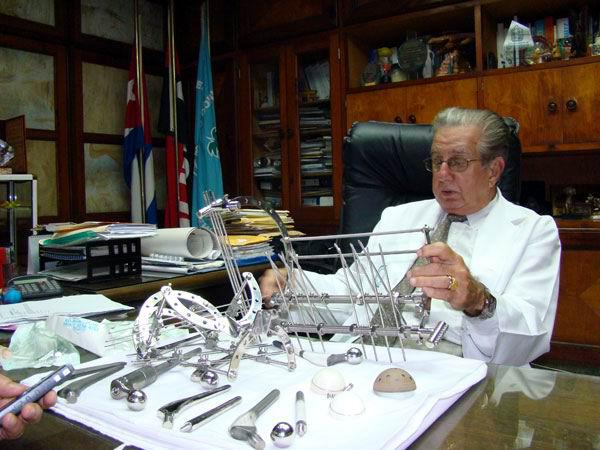 Cuban hospitals offer a range of treatment options with state-of-the-art surgical technology, such as titanium implants, for the treatment of spinal deformities, fractures, herniated discs, and many other diseases of the vertebral column, including surgery of the vertebral column for the elderly. RALCA external fixator, introduced in surgical procedures on the island from the 1970s. This orthopaedic apparatus, used to treat complex fractures and severe multiple injuries, is attached to the bone in order to lengthen it and correct both trauma wounds and congenital or acquired malformations, resulting in remarkable improvements in patient quality of life. It has multiple uses in vascular injuries and bone fragment displacement, and has proven to be very effective in natural disaster and armed conflict situations. RALCA takes its name from Dr. Rodrigo Álvarez Cambra, creator of the mechanical device, which is placed above the skin and attached to the bone using pins or wires for therapeutic purposes.
Cuban hospitals offer a range of treatment options with state-of-the-art surgical technology, such as titanium implants, for the treatment of spinal deformities, fractures, herniated discs, and many other diseases of the vertebral column, including surgery of the vertebral column for the elderly. RALCA external fixator, introduced in surgical procedures on the island from the 1970s. This orthopaedic apparatus, used to treat complex fractures and severe multiple injuries, is attached to the bone in order to lengthen it and correct both trauma wounds and congenital or acquired malformations, resulting in remarkable improvements in patient quality of life. It has multiple uses in vascular injuries and bone fragment displacement, and has proven to be very effective in natural disaster and armed conflict situations. RALCA takes its name from Dr. Rodrigo Álvarez Cambra, creator of the mechanical device, which is placed above the skin and attached to the bone using pins or wires for therapeutic purposes.
You can also take advantage of Cuban advanced surgical treatments for back operations, foot deformities, shoulder, hip and ankle arthroscopy, minimally invasive surgery, infections, complex hip conditions in older adults, injuries in high performance sports (Sports Traumatology), injured tendon / ligament in ankle and other developments in the field of orthopedics. If you're suffering from articular degenerative diseases and congenital and acquired (post-traumatic) malformations Cuban doctors can also help.
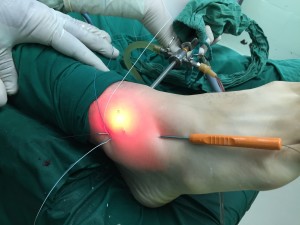 Besides the specialties of Orthopedics and Traumatology have the largest number of cases with the use of stem cells in Cuba. By the end of 2017, the total number of domestic patients treated with stem cells amounted to 3000. The use of stem cells is promising in therapy of people suffering from serious renal insufficiency of the lower limbs, to avoid amputation in a range of 58 to 80% of patients who had this ailment. A marked improvement is also recorded in about 85% of patients presenting chronic arterial insufficiency of the lower members, who, because of the intense pain, were obliged to stop the walk before the 150 meters. Some of them today walk a kilometer and more without feeling discomfort. Results are also encouraging in complex fractures, bone cysts, aseptic necrosis of the hip, Arthritis injury joint degenerative, particularly of the knee, periodontitis, heart attacks, paraplegia due to injuries of the spine and spinal cord injury, and in children and adolescents with Muscular Dystrophy Duchenne (DMD).
Besides the specialties of Orthopedics and Traumatology have the largest number of cases with the use of stem cells in Cuba. By the end of 2017, the total number of domestic patients treated with stem cells amounted to 3000. The use of stem cells is promising in therapy of people suffering from serious renal insufficiency of the lower limbs, to avoid amputation in a range of 58 to 80% of patients who had this ailment. A marked improvement is also recorded in about 85% of patients presenting chronic arterial insufficiency of the lower members, who, because of the intense pain, were obliged to stop the walk before the 150 meters. Some of them today walk a kilometer and more without feeling discomfort. Results are also encouraging in complex fractures, bone cysts, aseptic necrosis of the hip, Arthritis injury joint degenerative, particularly of the knee, periodontitis, heart attacks, paraplegia due to injuries of the spine and spinal cord injury, and in children and adolescents with Muscular Dystrophy Duchenne (DMD).
| Pathology | Intervention | Hospitalization in private room(nights) | Hospitalization Progressive care (nights) |
Anesthesia | Price (CUC) |
| Hip degenerative arthropathy |
Total hip arthroplasty |
20 | 1 | RA | 5100.00 |
| Hip deformity | Hip correcting osteotomy | 14 | RA | 3750.00 |
|
| Hip flexion contracture | Hip flexor elongation | 21 | GA | 3930.00 |
|
| Lumbar herniated disc | Lumbar discectomy | 10 | GA | 3865.00 |
|
| Relapsing lumbar herniated disc | Discectomy and release of roots | 14 | GA | 4770.00 |
|
| Lumbar herniated disc | Lumbar discectomy + posterior-lateral intersomatic fusion (plif) with titanium implant (1 space) | 10 | GA | 4363.00 |
|
| Lumbar herniated disk | Lumbar discectomy + posterior-lateral intersomatic fusion (plif) with titanium implant (2 spaces) | 10 | GA | 4863.00 |
|
| Cervical herniated disc | Cervical discectomy | 7 | GA | 3200.00 |
|
| Dorsal rachiomedullary compressive process | Decompression and stabilization Anterior dorsal column | 13 | 1 | GA | 6518.00 |
| Dorsal rachiomedullary compressive process | Decompression and stabilizationPosterior dorsal column | 13 | 1 | GA | 6518.00 |
| Lumbar rachiomedullary compressive process | Decompression and stabilization Anterior lumbar column | 13 | 1 | GA | 6238.00 |
| Lumbar rachiomedullary compressive process | Decompression and stabilizationPosterior lumbar column | 6 | 2 | GA | 6238.00 |
| Cervical rachiomedullary compressive process | Decompression and stabilization Anterior cervical column | 9 | 1 | GA | 5160.00 |
| Cervical rachiomedullary compressive process | Decompression and stabilizationPosterior cervical column | 9 | 1 | GA | 5660.00 |
| Scoliosis (- 60o?) | Correction of -60o scoliosis | 14 | 1 | GA | 5750.00 |
| Scoliosis (+ 60o?) | Correction of + 60?o scoliosis | 27 | 1 | GA | 7920.00 |
| Xiphosis (40 - 60o?) | Correction of Xiphosis (40?o-60?o) | 14 | 1 | GA | 5750.00 |
| Xiphosis (+ 60o) | Correction of + 60o xiphosis | 27 | 1 | GA | 7920.00 |
| Degenerative arthroplasty of the knee | Knee arthroplasty with unilateral prosthesis implant | 14 | RA | 4615.00 |
|
| Degenerative arthroplasty of bilateral knee | Knee arthroplasty with bilateral prosthesis | 14 | RA | 6850.00 |
|
| Angular deformity of the knee | Unilarteral knee correcting osteotomy | 21 | RA | 3815.00 |
|
| Angular deformity of the knee | Bilateral knee correcting osteotomy | 21 | RA | 4940.00 |
|
| Contracture in knee flexion | Elongation of knee flexors | 14 | GA | 3240.00 |
|
| Internal unilateral patellar disarrangement | Unilateral therapeutic arthroscopy | 3 | RA | 1923.00 |
|
| Internal unilateral patellar disarrangement | Unilateral therapeutic arthroscopy | 3 | GA | 2113.00 |
|
| Internal bilateral patellar disarrangement | Bilateral therapeutic arthroscopy | 4 | RA | 3063.00 |
|
| Internal bilateral patellar disarrangement | Bilateral therapeutic arthroscopy | 4 | GA | 3353.00 |
|
| Deformity of the foot | Arthrodesis of the back part of the foot | 10 | RA | 2820.00 |
|
| Carpal tunnel syndrome | Release of the median nerve | Outpatient | RA | 1170.00 |
All Programs include: Hospitalization, medical fees, pre-operation examination, surgical intervention, right to the operating room, anesthesia and recovery.
Exclude: Blood, derivatives or substitutes of blood and medication. According to the intervention the patient will require prosthesis or osteosynthesis material whose cost is not included in the program.


